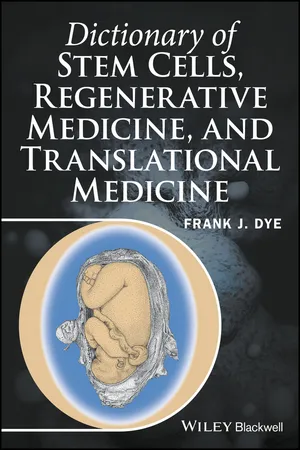
Dictionary of Stem Cells, Regenerative Medicine, and Translational Medicine
- English
- ePUB (mobile friendly)
- Available on iOS & Android
Dictionary of Stem Cells, Regenerative Medicine, and Translational Medicine
About This Book
Stem cells, regenerative medicine, and translational medicine, are all areas of burgeoning basic research and clinical application.
This dictionary includes the fundamental terminology of each of these areas, the major discoveries and significant scientists that comprise the history and current development of the field, as well as a number of concepts. The vocabulary is presented within the broader lexicon of developmental biology and embryology, which provides context for these three fields. Topics covered range from stem cells (embryonic, adult, and iPSCs) to teratology. The inclusion of extensive cross-referencing of the terms will enable readers to broaden their understanding of them.
The Dictionary of Stem Cells, Regenerative Medicine, and Translational Medicine will provide both the basic background terminology needed by pre-health professions/biology major undergraduate students and early-stage graduate students, as well as being a valuable reference for university professors, researchers and peers in related disciplines.
Frequently asked questions
Information
P
- p53
- a transcription factor that is one of the most important regulators of cell division.
- P-cadherin
- also called placental cadherin, a cell adhesion molecule that is apparently expressed primarily on those placental cells (trophoblast cells) that contact the uterine wall and the uterine wall epithelium; it is possible that P-cadherin facilitates the connection of the trophoblast to the uterus.
- P element
- See: transposable element.
- P-granules
- ribonucleoprotein complexes, found in early embryos of Caenorhabditis elegans, which probably function in specifying the germ cells.
- pacemaker
- the sinoatrial node that functions to stimulate the heart and to control the rate of heartbeat; that which controls the rate of heartbeat.
- pachytene
- the third stage of prophase I of meiosis, during which the chromosomes complete synapsis.
- paedogenesis
- reproduction by the immature organism; an example is in the Gall-midge Miastor, whose larvae give rise asexually to daughter larvae, thus involving parthenogenesis and viviparity; the progeny eat their way out of the parent larva and reproduce in a similar manner; sexual acceleration; a type of paedomorphosis where sexual development is accelerated and terminal stages of development in other systems are omitted after reaching sexual maturity.
- paedomorphosis
- where late developmental sequences in certain organs or systems are simply omitted and formerly juvenile characteristics thus appear in the terminal (adult) or subterminal (subadult) stages. The character that was embryonic or juvenile in the ancestor becomes adult in the descendant; the neotenic salamanders (e.g., Necturus) are excellent examples; phylogenetic change in which adults retain juvenile characters.
- pair-rule genes
- Drosophila genes (e.g., even-skipped and fushi tarazu), expressed in a series of seven transverse stripes in the blastoderm, each pair-rule gene being expressed in alternate parasegments. The parasegments of the embryo are delimited by the activity of the pair-rule genes. Pair-rule gene expression is revealed by staining for the pair-rule proteins, which gives a striking zebra-striped embryo. The positions of the stripes of pair-rule gene expression are determined by the pattern of gap gene expression; a nonrepeating pattern of gap gene activity is converted into repeating stripes of pair-rule gene expression. Some pair-rule genes (e.g., even-skipped) define odd-numbered parasegments, whereas others (e.g., fushi tarazu) define even-numbered parasegments; however, the domains of expression of some pair-rule genes cross parasegment boundaries. Each stripe is specified independently. The independent localization of each of the stripes by the gap gene transcription factors requires that in each stripe, pair-rule genes respond to different concentrations and combinations of the gap gene transcription factors; i.e., the pair-rule genes require complex control regions with multiple binding sites for each of the different factors. Gap genes regulate pair-rule gene expression in each parasegment. With the initiation of pair-rule gene expression, the embryo becomes segmented; it is now divided into several unique regions, characterized mainly by the combinations of transcription factors being expressed in each; these include proteins encoded by the gap genes, the pair-rule genes, and the genes expressed along the dorsoventral axis. Most pair-rule genes code for transcription factors. Like gap genes, the activity of pair-rule genes is only temporary. During pair-rule gene expression, the blastoderm becomes cellularized. See: even-skipped.
- paired and aligned spermatogonia
- spermatogonial stem cells (A(s) spermatogonia) are single cells that either renew themselves or produce A(pr) (paired) spermatogonia predestined to differentiate. In turn, the A(pr) divide into chains of A(al) (aligned) spermatogonia that also divide. The ratio between self-renewal and differentiation of the stem cells is regulated by glial cell line-derived neurotrophic factor produced by Sertoli cells, while the receptors are expressed in stem cells. A(s), A(pr), and A(al) spermatogonia proliferate d...
Table of contents
- Cover
- Title Page
- Copyright
- Table of Contents
- Dedication
- Preface
- A
- B
- C
- D
- E
- F
- G
- H
- I
- J
- K
- L
- M
- N
- O
- P
- Q
- R
- S
- T
- U
- V
- W
- X
- Y
- Z
- References
- Color Plates
- End User License Agreement